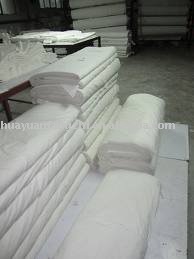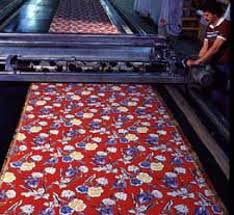If you are wondering what is behind the recent increase in the retail prices of your quilting cottons [and all cotton goods for that matter], here is a brief explaination to help yo
Cotton is a commodity and like all commodities prices are increasing. Most would attribute this primarily to the weakening dollar. As confidence in the dollar erodes, commodities rise in value. The doll ar has weakened, of course, as our national debt has skyrocketed. Premium fabric brands are printed in Japan and Korea. The dollar has weakened by approximately 20 percent to these countries' currencies.
ar has weakened, of course, as our national debt has skyrocketed. Premium fabric brands are printed in Japan and Korea. The dollar has weakened by approximately 20 percent to these countries' currencies.
 ar has weakened, of course, as our national debt has skyrocketed. Premium fabric brands are printed in Japan and Korea. The dollar has weakened by approximately 20 percent to these countries' currencies.
ar has weakened, of course, as our national debt has skyrocketed. Premium fabric brands are printed in Japan and Korea. The dollar has weakened by approximately 20 percent to these countries' currencies. We are also wrestling with a worldwide cotton shortage. This shortage is exacerbat ed by flooding in Pakistan, heavy rains in China and hail damage in west Texas. India has stopped the exportation of cotton altogether, and China has severely restricted its cotton exportation because rising wealth is boosting consumption in their own country. Labor shortages in China have also contributed to the reduction in available cotton. Indeed, the entire globe is competing for a finite amount of product. As is sometimes the case, when commodities spike in price, speculators hold out for better prices, and it appears that is what some greige goods produ
ed by flooding in Pakistan, heavy rains in China and hail damage in west Texas. India has stopped the exportation of cotton altogether, and China has severely restricted its cotton exportation because rising wealth is boosting consumption in their own country. Labor shortages in China have also contributed to the reduction in available cotton. Indeed, the entire globe is competing for a finite amount of product. As is sometimes the case, when commodities spike in price, speculators hold out for better prices, and it appears that is what some greige goods produ cers may be doing.
cers may be doing.
 ed by flooding in Pakistan, heavy rains in China and hail damage in west Texas. India has stopped the exportation of cotton altogether, and China has severely restricted its cotton exportation because rising wealth is boosting consumption in their own country. Labor shortages in China have also contributed to the reduction in available cotton. Indeed, the entire globe is competing for a finite amount of product. As is sometimes the case, when commodities spike in price, speculators hold out for better prices, and it appears that is what some greige goods produ
ed by flooding in Pakistan, heavy rains in China and hail damage in west Texas. India has stopped the exportation of cotton altogether, and China has severely restricted its cotton exportation because rising wealth is boosting consumption in their own country. Labor shortages in China have also contributed to the reduction in available cotton. Indeed, the entire globe is competing for a finite amount of product. As is sometimes the case, when commodities spike in price, speculators hold out for better prices, and it appears that is what some greige goods produ cers may be doing.
cers may be doing.Cotton factory in China. Local farmers bring their raw cotton to a large cotton processing factory outside Yuli, Xinjiang, China. The cotton is gathered into the large piles seen here. Eventually the raw cotton will be processed to remove its seeds, and it will then be compacted into bales for shipment to washing and spinning factories.
Historically, when cotton prices would rise dramatically, mills could blend their way to a cheaper product. The quilting culture simply does not support a blended product, not to mention the fact that polyester (a petroleum derivative) prices are also rising. 
Truly we are dealing with a "perfect storm" of problems when it comes to fabric costs.
The quilting industry is also dealing with a significant decrease in the number of print mills that can print the smaller minimums [the quilting] industry requires, as well as the 16 to 18 screens so frequently used.
There were once approximately 25 printers that could do this type of work; we are down to 10 now! This puts upward pressure on printing costs. We still have six mills left in America, but they produce carpet, upholstery, etc. They may do some high speed rotary printing, but with large minimums and only four to six screens. They do not do low minimum flat bed press printing using 18 screens.
Stephanie Dell'olio, president, retail division of Marcus Bros., recently exclaimed, "We have experienced shortages in the past, but this particular set of conditions is like no other we have ever experienced in our 100-year history."
One reason these price hikes are creating so much consternation is that we have experienced so little inflation in the fabric industry over the last 20 years. My wife Roxanne took quilting classes when we lived in Phoenix 20 years ago. She paid $6.99 per yard for Hoffman of California prints. The industry was much smaller then, and Hoffman was considered (as it still is today) a premier brand. Today Hoffman prints are $9.99 per yard in many quilt shops. This is only a 44 percent increase in 20 years!
In 1990 a loaf of bread was $0.70. In 2010 a comparable loaf was $2.69. That's a 287% increase. The average cost of a new car in 1990 was $16,900. In 2010 the average price of a new car was $27,000. This is a 65% increase. One pound of ground beef was $0.89 in 1990. In 2010 a pound of ground beef was $3.29. This is a 270% increase.
You can look at just about anything you purchase and if you compare the price of that item in 1990 to the price today you may just find quilting cotton is still a good value worth the joy it brings you!
Jim Salinas has close to 40 years of experience in the fabric industry. He was a store management and then district manager with Hancock Fabrics for 17 years and later vice president of marketing for Cloth World, director of fabric merchandising for Michael's Arts and Crafts and executive vice president of House of Fabrics. He has been a sales associate for Moda Fabrics since 1997.
Copyright 2011 American Quilt Retailer

7 comments:
Great Article, sheds some light on the cost of not just fabric but everything else related to cotton. Thanks for posting it
Thanks for this article. It provides me with more information than I had before.
I knew that cotton prices were going through the roof, because even though there is a shortage of hay in CA they are tearing it out this year to plant cotton.
but I'm really hoping there is not going to be a 200%+ jump in fabric prices.
Wonderful article Whmbrella, thank you!
I think this is a good article. It shows us all what we are dealing with as pertains to our industry. Fabric is the bottom line for us to work so we need to be aware of what goes into it's making and it's cost. Our customers need to be aware of this as it naturally is what makes the cost of our product go up.
Thanks for this helpful post. Now I feel great that I've hoarded so much fabric at a lower cost!
Thank you so much--really interesting!
Post a Comment